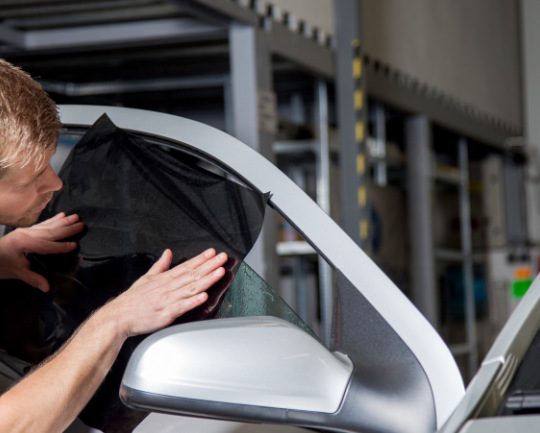Tinted windows have become famous for vehicle owners and homeowners alike, offering a range of benefits from enhanced privacy to improved aesthetics. Visible Light Transmission (VLT) is a crucial factor in determining the effectiveness of tinted windows. In this comprehensive guide, we will delve into the intricacies of VLT, exploring its significance, the science behind it, and the various applications of tinted windows.
What is Visible Light Transmission (VLT)?
Visible Light Transmission, or VLT, refers to the percentage of visible light that can pass through a tinted window. It is a critical factor in determining how dark or light a window appears and plays a pivotal role in regulating the amount of sunlight entering a space. VLT is expressed as a percentage, with higher percentages indicating more light transmission and vice versa.
The Science Behind VLT
Understanding VLT involves delving into the physics of light and how it interacts with different materials. When light passes through a tinted window, it encounters the tint film designed to absorb or reflect a certain percentage of the incoming light. The remaining light is transmitted through the glass, determining the VLT of the window.
The tint film comprises various materials, such as dyed polyester, metalized film, or ceramic particles, each with distinct VLT properties. Dyed films absorb and reflect light, metalized films reflect heat and ceramic films combine both properties while maintaining high VLT levels.
Regulatory Standards for VLT
Many regions have established regulatory standards for VLT in tinted windows to ensure safety and compliance. These standards vary, with some countries specifying permissible VLT percentages for different windows of a vehicle or building. Consumers must be aware of these regulations when considering tinting their windows to avoid legal complications.
Benefits of Tinted Windows
Tinted windows with advanced films offer a multifaceted solution beyond aesthetics. From protecting against harmful UV rays to enhancing privacy, here are some key advantages of opting for tinted windows:
- UV Ray Protection: Tinted windows offer effective protection against harmful UV rays. High-quality tint films can block a significant portion of UV radiation, reducing the risk of skin cancer and preventing furnishings and upholstery interior fading.
- Heat Reduction: By regulating the amount of sunlight entering a space, tinted windows help control the interior temperature. This can reduce energy consumption as air conditioning systems work more efficiently in maintaining a comfortable environment.
- Glare Reduction: Excessive glare from sunlight can be a safety hazard and cause discomfort. Tinted windows mitigate glare, providing a more comfortable driving experience and improving vehicle and building visibility.
- Privacy Enhancement: Tinted windows enhance privacy by limiting the visibility of the interior from the outside. This is particularly beneficial in residential settings and vehicles, offering occupants security.
Applications of Tinted Windows
Before exploring the various applications of tinted windows, it’s essential to recognize their versatility and impact on different environments. Tinted windows, influenced by Visible Light Transmission (VLT), serve multiple purposes, enhancing both functionality and aesthetics. Here are some key applications:
Automotive Tinting
Visible Light Transmission (VLT) is a critical factor in automotive tinting, with regulations specifying permissible percentages for different windows. Beyond enhancing the sleek aesthetics of a vehicle, tinted windows contribute significantly to the comfort and safety of occupants. By reducing glare, blocking harmful UV rays, and regulating interior temperature, automotive tinting ensures a more enjoyable driving experience. It also adds an extra layer of privacy, creating a secure and personalized atmosphere within the vehicle. Choosing the right VLT for automotive tinting is essential for meeting both regulatory requirements and the preferences of vehicle owners.
Residential Tinting
Homeowners opt for residential tinting as a multifaceted solution to enhance privacy, reduce energy costs, and protect furnishings from UV damage. Visible Light Transmission (VLT) considerations play a crucial role in helping homeowners choose the right tinting solution for their windows. Tinted windows create a more comfortable living environment by regulating sunlight, reducing glare, and maintaining a balanced interior temperature. Beyond practical benefits, residential tinting adds a touch of elegance to homes, elevating their aesthetic appeal. It’s a practical investment that combines privacy, energy efficiency, and UV protection for a more enjoyable living space.
Commercial Buildings
Tinted windows find widespread use in commercial buildings, addressing key concerns such as energy efficiency and creating a comfortable working environment. Visible Light Transmission (VLT) considerations are pivotal in balancing the need for natural light and the desire to reduce heat and glare. Tinted windows contribute to energy savings by regulating the influx of sunlight and optimizing the efficiency of heating, ventilation, and air conditioning systems. In commercial settings, where productivity and comfort are paramount, tinted windows enhance the overall workplace experience, providing occupants with a pleasant and conducive atmosphere.
 Choosing the Right VLT for Tinted Windows
Choosing the Right VLT for Tinted Windows
Selecting the appropriate Visible Light Transmission (VLT) for tinted windows involves carefully considering several factors to ensure functionality, compliance, and personal preferences.
- Regulatory Compliance: Research and understand local regulations for VLT percentages, mainly for automotive tinting. Ensure the chosen VLT falls within permissible limits to avoid legal complications.
- Purpose of Tinting: Identify the primary purpose, such as UV protection, heat reduction, glare reduction, or privacy enhancement. Different purposes may require specific VLT levels to achieve optimal results.
- Aesthetic Preferences: Consider personal preferences for window appearance, whether opting for a darker or lighter tint. Balance aesthetics with functionality, as darker tints generally have lower VLT percentages.
- Type of Tint Film: Understand the characteristics of dyed, metalized, and ceramic films, as they offer varying VLT levels and additional features. Dyed films absorb and reflect light, metalized films reflect heat and ceramic films combine both properties while maintaining higher VLT levels.
- Environmental Considerations: Consider the climate and environmental conditions in your area, adjusting VLT based on specific challenges. Prioritize heat reduction in warmer climates and glare reduction in regions with intense sunlight.
- Professional Installation: Regardless of VLT choice, ensure professional installation to guarantee effectiveness and avoid issues like bubbling or distortion.
By addressing these considerations, individuals can confidently choose the right VLT for their tinted windows, meeting regulatory requirements and aligning with personal preferences for aesthetics and functionality.
Conclusion
Visible Light Transmission is a crucial factor in the effectiveness of tinted windows, influencing their impact on privacy, comfort, and energy efficiency. Understanding VLT empowers consumers to make informed decisions, ensuring that the chosen tinting solution aligns with their specific requirements and regulatory standards, whether applied to vehicles, residential homes, or commercial buildings. As the demand for tinted windows continues to grow, this comprehensive guide is a valuable resource for those seeking to navigate the world of VLT and make well-informed choices for their tinting needs.




